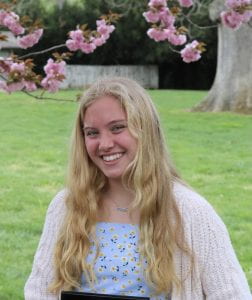
Student Leader Impact Story: Anne Shea
By Anne Shea
July 14, 2023
About the Author: Annie Shea is an undergraduate Chemical and Environmental Engineering student at Northeastern University. She has been a student and 3-time Service-Learning teaching assistant for the stacked Cornerstones of Engineering course, which partners with community organizations to provide STEAM opportunities for elementary students. She is also a team leader and peer mentor within the university’s Alliance of Civically Engaged Students (ACES). She is currently working in a co-op position at Advent Technologies Holdings, Inc., which is dedicated to developing and manufacturing fuel cells in the renewable energy sector.
My service-learning experience began my first semester when I enrolled in a Service-Learning section of Cornerstones of Engineering. I didn’t know what to expect from the course and certainly could not have anticipated the impact that choice would have on my college experience. Upon hearing my professor’s description – a partnership between our course and an afterschool elementary STEAM club, I applied to be a lead mentor so that I could make the most of my Service-Learning experience. Each week, I went with a group of students to lead a lesson and activity at the elementary school. Meanwhile, I learned about human-centered engineering in the classroom: designing with real people in mind, with the goal of understanding and creating products catered to that population.
In this way, I learned what service learning is. It was not just community service in addition to classes but an intentional, interwoven pairing of the two to target both learning objectives and community goals. For the course’s major project, our “clients” were not a distant entity but the creative, curious elementary students who greeted me with waves, high fives, and thumb wars each time I entered their classroom. Designing with these friends in mind, I was dedicated to applying skills learned in class to create a product that would make them happy. The best project was not necessarily the most complex or technically impressive but the one which best responded to their unique goals, abilities, and ideas.
I happily accepted the opportunity to be a service-learning teaching assistant (S-L TA) for the following semester. This role allowed me to introduce other engineering students to Service-Learning and engage with fellow Service-Learning student leaders. Through this collaboration, I observed the versatility of Service-Learning in its application across a wide variety of disciplines. Discussing with S-L TAs for courses ranging from language to nutrition, I learned reflection and communication strategies to make partnerships more successful. I worked closely with my faculty member and community partner to create engaging STEAM activities, prepare university students for Service-Learning, and guide meaningful reflection around their experiences and course content. In doing so, I developed a much greater understanding of our partnership. I learned firsthand the mutual goals, communication structures, and best practices that are essential to our Service-Learning relationship. My faculty member, community partner, and I recognized that this “recipe for success” could help other organizations with similar goals. We decided to compile and share the knowledge we had gained thus far in our Service-Learning experience.
Over the following months, we conducted literature reviews of existing Service-Learning and STEAM programs and synthesized our own student work samples, evaluation surveys, cumulative feedback log, and personal experience to create a STEAM x Service-Learning framework for success. This framework documents our efforts, solidifies our current organizational system, and acts as an institutional structure that can be shared with the K-12 and engineering education community. We presented a research paper detailing our framework at the 2023 American Society for Engineering Education’s Annual Conference and also created a website to make our STEAM activities publicly available. Our framework serves as an adaptable template for K-12 practitioners looking to set up successful STEAM programs and begin partnering with university Service-Learning efforts. In sharing our best practices, we hope to encourage student engagement in STEAM and human-centered design at all levels.
This experience greatly strengthened my passion for Service-Learning and the expansion of accessible STEAM educational opportunities. Workshops and technical sessions from Service-Learning practitioners across various universities reinforced my experiences of Service-Learning’s benefits for students and communities alike. The conference also introduced me to avenues for future collaboration and potential directions for future research. I am eager to partner with other organizations in broadening STEAM engagement and to conduct further research toward developing and evaluating such partnerships.
Unveil the full story of our remarkable efforts and groundbreaking initiatives on our web page on the thrilling 2022-2023 year!